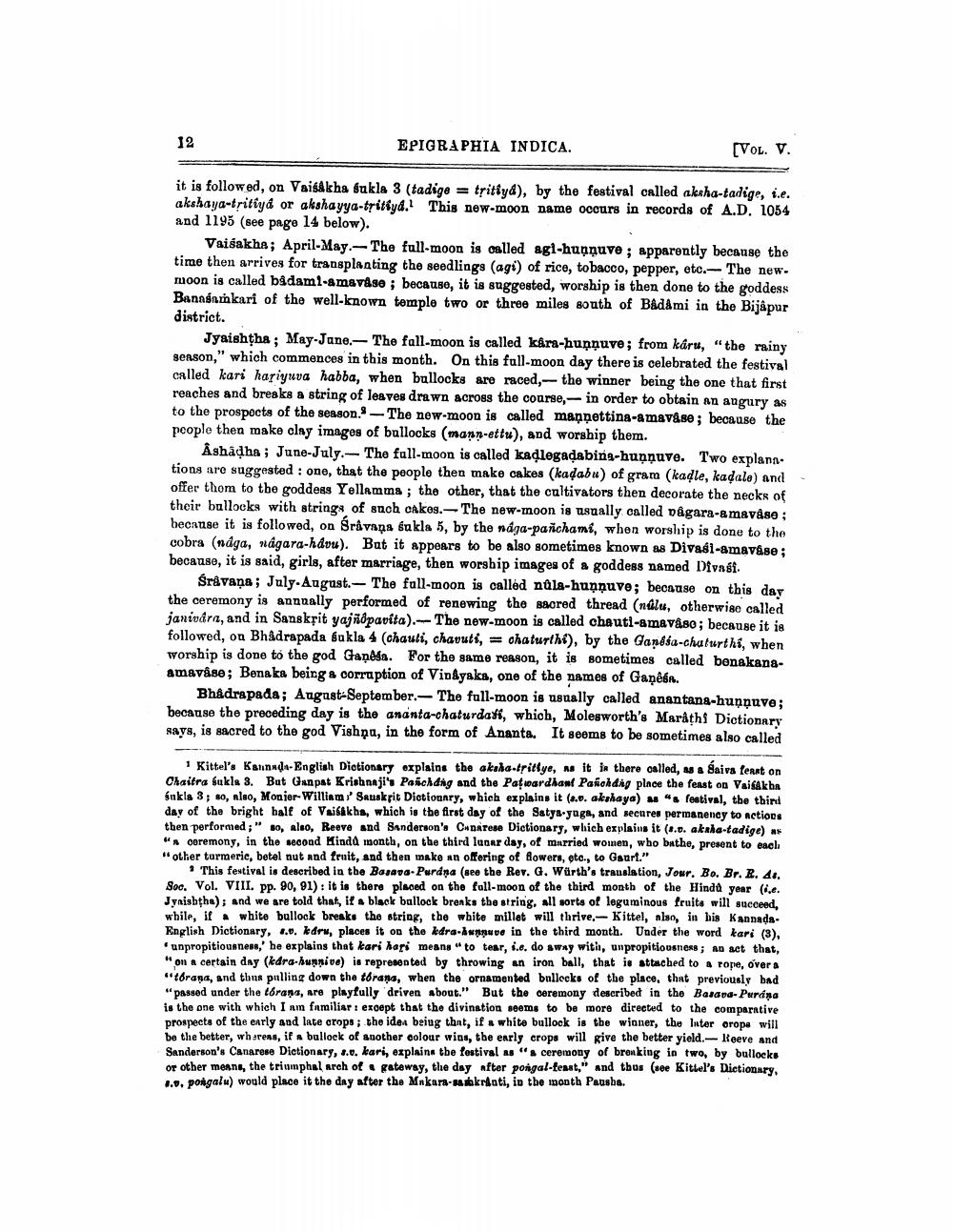________________
12
EPIGRAPHIA INDICA.
[VOL. V.
it is followed, on Vaisakha Sukla 3 (tadige = tritiyd), by the festival called akaha-tadige, i.e. akshaya-tsitiya or akshayya-tritiya. This new-moon name occurs in records of A.D. 1054 and 1195 (see page 14 below).
Vaisakha; April-May-The full-moon is oalled agi-hunnuve; apparently because the time then arrives for transplanting the seedlings (agi) of rice, tobacco, pepper, etc.- The new. moon is called badaml-amavise ; because, it is suggested, worship is then done to the goddess Banaśnănkari of the well-known temple two or three miles south of Badami in the Bijapur district.
Jyaishtha ; May-Jane - The fall-moon is called kära-huņņuve; from káru, "the rainy season," which commences in this month. On this full-moon day there is celebrated the festival called kari hariyuva habba, when bullocks are raced, the winner being the one that first reaches and breaks a string of leaves drawn across the course, in order to obtain an augury as to the prospocts of the season. - The new-moon is called mannettina-amavåse; because the people then make clny images of bullocks (mann-ettu), and worship them.
Åshadha ; June-July. The fall-moon is called kadlegadabing-huņņuve. Two explana. tions are suggested : one, that the people then make cakes (kadabu) of gram (kadle, kadale) and offer thom to the goddess Yellamms; the other, that the cultivators then decorate the necks of their bullocks with strings of such cakes. The new-moon is usually called vågara-& mevåse ; becntise it is followed, on Srivaņa lukla 5, by the ndga-panchami, when worship is done to the cobra (ndga, udgara-hdvu). Bat it appears to be also sometimes known as Divas1-amavåse ; because, it is said, girls, after marriage, then worship images of a goddess named Divasi.
Śråvaņa; July August. - The full-moon is called nula-huņņuve; because on this day the ceremony is annually performed of renewing the sacred thread (ndlu, otherwise called janivara, and in Sanskrit yajrðpavita). The new-moon is called chauti-amavåso; because it is followed, on Bhadrapada Sukla 4 (chauli, chavuti, = chaturthi), by the Gandía-chaturthi, when worship is done to the god Ganesa. For the same reason, it is sometimes called benakang. amavåse; Benaka being a corruption of Vinayaka, one of the names of Gaņēša.
Bhadrapada; August September.-The full-moon is usually called anantana-hunnuve; because the preceding day is the ananta-chaturdari, which, Molesworth's Marathi Dictionary says, is sacred to the god Vishnu, in the form of Ananta. It seems to be sometimes also called
1 Kittel's Kanndo-English Dictionary explains the akala-titlye, it is there oalled, Ma Baiva fent on Chaitra sukla 3. Bat Ganpat Krishnaji's Pacolding and the Paftoardhant Pafchdig place the feast on Vaiakba enkla 3, so, also, Monjor-William' Sauskrit Diotionnry, which explains it (.e. akshaya) ms" festival, the third day of the bright half of Vaisakha, which is the first day of the Satya-yage, and secures permanency to Actions then performed," so, also, Reeve and Sanderson's CHDATOS Dictionary, which explains it (1.0. akaka-tadige) as " ceremony, in the second Hindd month, on the third lugar day, of married women, who bathe, present to each other turmeric, betel nut and fruit, and then make an offering of flowers, etc., to Gaurt."
This festival is described in the Basava. Purdya (see the Rev. G. Würth's translation, Jour. Bo. Br. R. d. Soo. Vol. VIII. pp. 90, 91): it is there placed on the foll-moon of the third month of the Hindd year (i.e. Jynisbtha), and we are told that, it a black ballock breaks the string, all sorts of leguminous fruits will succeed, while, it white ballock bresk. the string, the white millet will thrive.- Kittel, also, in his KannadaEnglish Dictionary, 1.9. kdru, places it on the kdra-annure in the third month. Under the word kari (3).
unpropitiousness,' he explains that kari hari means "to tear, i.e. do away with unpropitiousness; an act that, " on certain day (kedra-bunniva) is represented by throwing an iron ball, that is attached to a rope, over a "Zbrana, and thus pulling down the tórans, when the ornamented bullocks of the place, that previously bad "passed under the torana, are playfully driven about." But the ceremony described in the Banana-Purdina is the one with which I am familiar i except that the divination seems to be more directed to the comparative prospects of the early and late crops; the idea being that, if a white bullock is the winner, the Inter orope will be the better, wbreas, if a bullock of another colour wiss, the early crops will give the better yield. Reeve and Sanderson's Canaros Dictionary, 2.0, kari, explains the festival as " ceremony of breaking in two, by bullocks or other means, the triumphal arch of gateway, the day after pongal feast," and thus (see Kittel's Dictionary, 1.9. pongalu) would place it the day after the Makara watakati, in the month Pausha.




